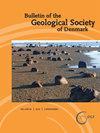丹麦晚中新世革兰氏黏土中Spinucella reimersi (von Koenen 1872)(腹足目:鼠足科)的出现及对该物种的修正描述
IF 1
4区 地球科学
Q2 Earth and Planetary Sciences
引用次数: 0
摘要
丹麦晚中新世格拉姆粘土中的Spinucella重新出现丹麦南部格拉姆富含云母的粘土(图1)自1848年以来就已为人所知,1857年后开始挖掘制砖坑(L.B.Rasmussen 1968,第10页)。此后不久,软体动物的采集工作就开始了,Semper(1861)研究了来自Gram的材料。19世纪下半叶,冯·科宁(18721882)和默奇(1874)进行了进一步的研究,包括来自葛兰的材料。E.S.Rasmussen(2005)对Gram Clay的地质背景进行了描述。有关动物群的进一步参考,请参见Schnetler(2005)。医生Martin Reimers于1841年开始在Gram做全科医生,是一位敏锐而熟练的粘土坑化石收藏家;毫无疑问,这引起了专业古生物学家的兴趣。Carinastarte vetula reimersi(Ravn1907)是Gram Clay中最常见的软体动物物种,Semper在一份未出版的手稿中为纪念Martin Reimers而命名。本研究描述了Martin Reimers与一种非常罕见且几乎被忽视的腹足纲物种Spinucella reimersi的联系,自1862年首次发现以来,这种腹足纲动物只遇到过两次。此外,两个新的标本允许对该物种进行修订描述。本文章由计算机程序翻译,如有差异,请以英文原文为准。
On the occurrence of Spinucella reimersi (von Koenen 1872) (Gastropoda: Muricidae) in the Late Miocene Gram Clay of Denmark, and an emended description of the species
Spinucella reimersi in the Late Miocene Gram Clay, Denmark The mica-rich clay at Gram in southern Denmark (Fig. 1) has been known since 1848, and digging of a pit for brick-making started after 1857 (L.B. Rasmussen 1968, p. 10). The collecting of molluscs started soon thereafter, and Semper (1861) studied material from Gram. Further studies in the second half of the 19th century, including material from Gram, were made by von Koenen (1872, 1882) and Mörch (1874). A description of the geological setting of the Gram Clay is found in E.S. Rasmussen (2005). For further references to the fauna, see Schnetler (2005). The physician Martin Reimers started as a general practitioner in Gram in 1841 and was a keen and skillful collector of fossils in the clay pit; without doubt this caught the interest of the professional palaeontologists. Carinastarte vetula reimersi (Ravn 1907), the most common mollusc species in the Gram Clay, was named in honour of Martin Reimers by Semper in an unpublished manuscript. The present study describes Martin Reimers’ connection to a very rare and almost neglected gastropod species, Spinucella reimersi, which since the first finding in 1862 has only been encountered twice. Furthermore, two new specimens have allowed an emended description of the species.
求助全文
通过发布文献求助,成功后即可免费获取论文全文。
去求助
来源期刊

Bulletin of the Geological Society of Denmark
GEOSCIENCES, MULTIDISCIPLINARY-
CiteScore
2.80
自引率
16.70%
发文量
28
审稿时长
>12 weeks
期刊介绍:
The Bulletin publishes contributions of international interest in all fields of geological sciences on results of new work on material from Denmark, the Faroes and Greenland. Contributions based on other material may also be submitted to the Bulletin if the subject is of relevance for the geology of the area of primary interest.
 求助内容:
求助内容: 应助结果提醒方式:
应助结果提醒方式:


